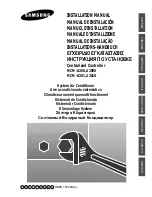
27
MAINTENANCE
To ensure continuing high performance, and to minimize the
possibility of premature equipment failure, periodic maintenance
must be performed on this equipment. This packaged unit should
be inspected at least once each year by a qualified service person. To
troubleshoot unit, refer to Table 10, Troubleshooting Chart.
NOTE TO EQUIPMENT OWNER: Consult your local dealer
about the availability of a maintenance contract.
PERSONAL INJURY AND UNIT DAMAGE HAZARD
Failure to follow this warning could result in personal injury
or death and possible unit component damage.
The ability to properly perform maintenance on this
equipment requires certain expertise, mechanical skills, tools
and equipment. If you do not possess these, do not attempt to
perform any maintenance on this equipment, other than those
procedures recommended in the Owner’s Manual.
!
WARNING
ELECTRICAL SHOCK HAZARD
Failure to follow these warnings could result in personal
injury or death:
1. Turn off electrical power to the unit before performing any
maintenance or service on this unit.
2. Use extreme caution when removing panels and parts.
3. Never place anything combustible either on or in contact
with the unit.
!
WARNING
UNIT OPERATION HAZARD
Failure to follow this caution may result in equipment damage
or improper operation.
Errors made when reconnecting wires may cause improper
and dangerous operation. Label all wires prior to
disconnecting when servicing.
CAUTION
!
The minimum maintenance requirements for this equipment are as
follows:
1. Inspect air filter(s) each month. Clean or replace when
necessary.
2. Inspect indoor coil, drain pan, and condensate drain each
cooling season for cleanliness. Clean when necessary.
3. Inspect indoor fan motor and wheel for cleanliness each
cooling season. Clean when necessary.
4. Check electrical connections for tightness and controls for
proper operation each cooling season. Service when
necessary.
5. Check for restrictions on inducer outlet. Clean flue hood.
6. Inspect burner compartment before each heating season for
rust, corrosion, soot or excessive dust.
7. Inspect all accessories. Perform any service or maintenance
to the accessories as recommended in the accessory
instructions.
Step 1—Air Filter
IMPORTANT
: Never operate the unit without a suitable air filter
in the return--air duct system. Always replace the filter with the same
dimensional size and type as originally installed. See Table 1 for
recommended filter sizes.
Inspect air filter(s) at least once each month and replace
(throwaway--type) or clean (cleanable--type) at least twice during
each cooling season and twice during the heating season, or
whenever the filter becomes clogged with dust and lint.
Step 2—Indoor Fan and Motor
NOTE
: All motors are pre--lubricated. Do not attempt to lubricate
these motors.
For longer life, operating economy, and continuing efficiency, clean
accumulated dirt and grease from the blower wheel and motor
annually.
Step 3—Inducer Blower
NOTE
: All motors are pre--lubricated. Do not attempt to lubricate
these motors.
Clean periodically to assure proper airflow and heating efficiency.
Inspect blower wheel every fall and periodically during the heating
season. For the first heating season, inspect blower wheel
bi--monthly to determine proper cleaning frequency.
Step 4—Limit Switch
Remove unit access panel to gain access to the limit switch. The limit
switch is located above the indoor blower housing.
NOTE
: On small chassis units, a second limit switch is located
beside the indoor blower housing.
Step 5—Burner Ignition
Unit is equipped with a direct spark ignition 100 percent lockout
system. Ignition module is located in the control box. Refer to
additional information in the Start--Up & Troubleshooting section
for Status Code information.
Step 6—Main Burners
At the beginning of each heating season, inspect for deterioration or
blockage due to corrosion or other causes. Observe the main burner
flames and adjust, if necessary.
EQUIPMENT DAMAGE HAZARD
Failure to follow this caution may result in equipment damage
or improper operation.
When servicing gas train, do not hit or plug orifice spuds.
CAUTION
!
Removal of Gas Train
To remove the gas train for servicing:
1. Shut off main gas valve.
2. Shut off power to unit.
3. Remove unit access panel.
4. Disconnect gas piping at unit gas valve.
5. Remove wires connected to gas valve. Mark each wire.
6. Remove ignitor and sensor wires at the ignitor module.
7. Remove the mounting screw that attaches the burner rack to
the unit base.
8. Slide the burner rack out of the unit.
9. To reinstall, reverse the procedure outlined above.
Step 7—Inducer Pressure Switch
Inspect pressure switch connections. Inspect pressure switch tube
for cracks or restrictions. Replace if needed.
ELECTRICAL SHOCK HAZARD
Failure to follow this warning could result in personal injury
or death.
Disconnect and tag electrical power to the unit before cleaning
and lubricating the blower motor and wheel.
!
WARNING
577D










































